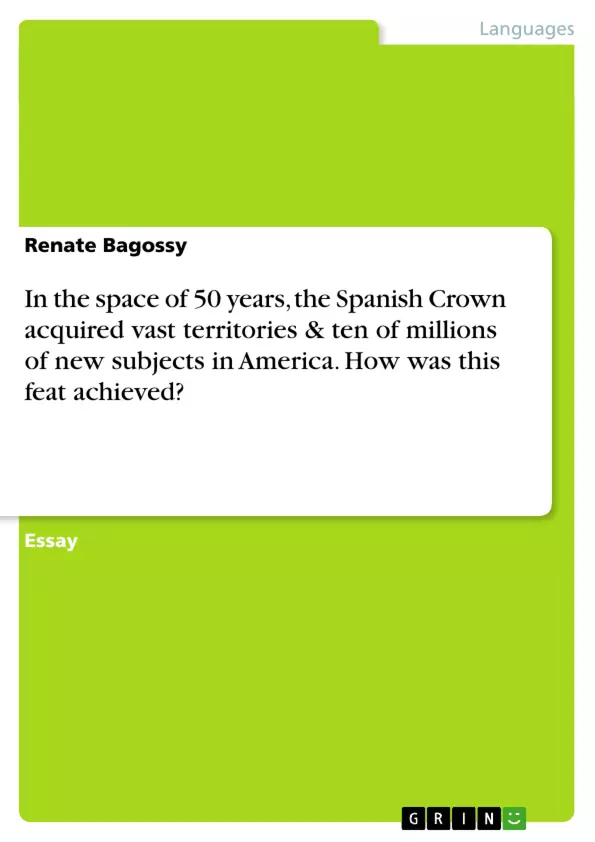In the space of 50 years, the Spanish Crown acquired vast territories & ten of millions of new subjects in America. How was this feat achieved? When Christopher Columbus set sail to the west in 1492, he thought, he was going to find the westward sea-route to India. At that time nobody knew that there was a big, undiscovered continent in-between. What started as a small excursion by Columbus, ended up in the conquest of rather big territories on the main land by men like Hernán Cortés, Francisco Pizarro and Diego de Almagro. The ”discovery, conquest, and colonisation marks the Spanish Conquista as a turning-point in history and one of the most stupendous outpourings of human energies on record.”1 Although during the conquest the natives were superior in numbers, the Spaniards managed it to make them to their subject. Many different factors played a role in this achievement. One of them was the fact, that once the Spaniards realised, that there was a big possibility in front of them, they acted quickly and effectively. During the time the Spaniards were colonising the islands in the Caribbean, they also started to make some expeditions to the main land. Rumours about rich kingdoms arrived to them while having contact with natives, and so it lasted just a short time until Cortés and the others started to conquer the mainland.
Table of Contents
- When Christopher Columbus set sail to the west in 1492, he thought, he was going to find the westward sea-route to India.
- These conquests were \"meeting[s] of two branches of humanity which had previously been unknown to each other”.
- The Spaniards could easily communicate with each other, even over big distances, as they could read and write.
- The Spanish conquistadores all had good qualities as leaders: Cortés, for example, was encomendero in Cuba before he came to the mainland to conquer Mexico, so he already had experiences with natives.
- Here it is important to mention, that the conquest was not easy at all for the Spaniards.
- Another very important factor was, that the conquerors brought a lot of diseases with them, which the Indians did not know.
- Another important factor was the stability of the „homeland” Spain.
- When the Spaniards arrived on the islands and on the mainland, they encountered - in their eyes pagans who never heard about the word of God.
- Within a few decades the Spaniards conquered big territories of the American continent.
Objectives and Key Themes
This text examines the rapid expansion of the Spanish Crown in the Americas during the 16th century, exploring how they managed to conquer vast territories and subdue millions of indigenous people. It delves into the key factors that contributed to this remarkable achievement, from military tactics and technological advantages to the impact of disease and the role of religion in justifying the conquest.
- Technological and Military Advantages of the Spaniards
- The Role of Disease in the Conquest
- The Cultural Shock Experienced by the Native Populations
- Spanish Leadership and Organization
- The Impact of the Conquest on Native Societies
Chapter Summaries
- The text begins by introducing the historical context of the Spanish conquest, emphasizing the ambition of the Spanish Crown to expand its territories and influence. It highlights the role of Christopher Columbus's voyages and the subsequent exploration of the American mainland.
- This chapter delves into the significant differences between the Spaniards and the indigenous populations they encountered. It highlights the technological and military superiority of the Spaniards, who possessed advanced weaponry and tactics, compared to the indigenous populations who were still in the Stone Age. The chapter also explores the cultural shock experienced by the indigenous people as they encountered unfamiliar technology and practices.
- The chapter explores the advantages the Spaniards held in communication and organizational structures. The ability to read and write allowed for efficient communication and coordination, while the indigenous groups lacked a unified language system and were often divided by tribal allegiances.
- The text highlights the key qualities of Spanish leadership, particularly the role of figures like Hernán Cortés and Francisco Pizarro. It emphasizes their ability to motivate and unite their men, ultimately leading to successful conquests.
- The chapter examines the challenges the Spanish conquistadores faced, including navigating difficult terrain and overcoming resistance from indigenous populations. It also discusses the significant impact of diseases introduced by the Spaniards, which devastated indigenous populations and contributed to their vulnerability.
- The chapter focuses on the role of religion in the conquest. The Spanish viewed themselves as bringing Christianity to the indigenous people and justified their actions by portraying the indigenous populations as pagans. This chapter also highlights the cultural shock experienced by indigenous populations and the loss of faith in their own beliefs.
Keywords
The main keywords and focus topics of this text include: Spanish conquest, Americas, indigenous populations, technological superiority, disease, cultural shock, leadership, religion, and the impact of European colonization on native societies.
- Quote paper
- Renate Bagossy (Author), 2001, In the space of 50 years, the Spanish Crown acquired vast territories & ten of millions of new subjects in America. How was this feat achieved?, Munich, GRIN Verlag, https://www.grin.com/document/26386



